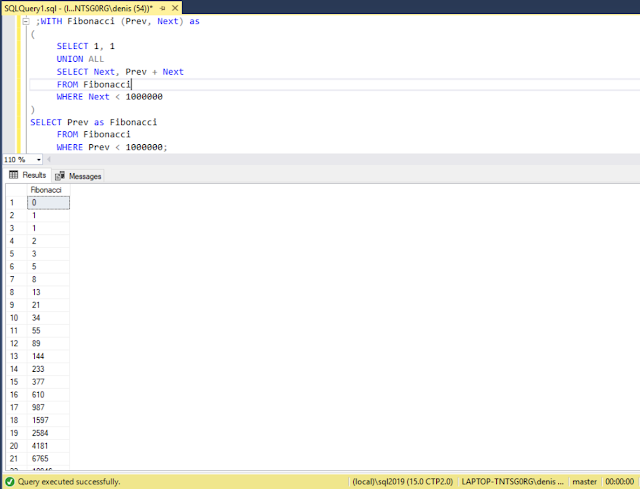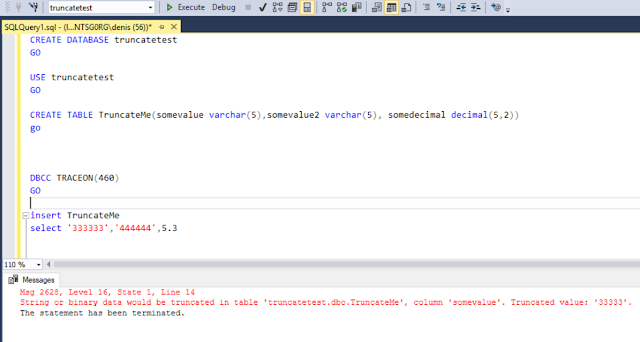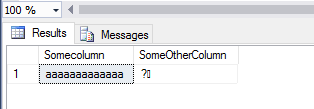It has been a while since I wrote some of my best practices posts. I decided to revisit these posts again to see if anything has changed, I also wanted to see if I could add some additional info.
Today we are going to look at cursors
Today we are going to look at cursors
Why do we hate those poor cursors?
Let's first see why people tend to use cursors. Let's say you come from a procedural language and this is the first time you are using SQL. In the procedural language you know how to traverse a list, you of course will look for something that is similar in SQL........bingo!!! you found it...the almighty cursor....the crusher of almost all SQL Server performance. You start using it, your code works, you are happy, life is good.
Now a team member tells you that the cursor is evil and should never ever be used. You are confused, if a cursor is never to be used then why is it part of the language? Well you might say the same for the GOTO statement, this exists in SQL. Edsger Dijkstra's letter Go To Statement Considered Harmful was published in the March 1968 Communications of the ACM.
Now a team member tells you that the cursor is evil and should never ever be used. You are confused, if a cursor is never to be used then why is it part of the language? Well you might say the same for the GOTO statement, this exists in SQL. Edsger Dijkstra's letter Go To Statement Considered Harmful was published in the March 1968 Communications of the ACM.
The reason that cursors are evil is that they tend to be slower than a set based solution. Cursors are not needed for 99% of the cases. SQL is a set based language, it works best with sets of data, not row by row processing, when you do something set based it will generally perform hundreds of times faster than using a cursor.
Take a look at this code
CREATE FUNCTION dbo.cursorEnroll ()
RETURNS INT AS
BEGIN
DECLARE @studentsEnrolled INT
SET @studentsEnrolled = 0
DECLARE myCursor CURSOR FOR
SELECT enrollementID
FROM courseEnrollment
OPEN myCursor;
FETCH NEXT FROM myCursor INTO @studentsEnrolled
WHILE @@FETCH_STATUS = 0
BEGIN
SET @studentsEnrolled = @studentsEnrolled+1
FETCH NEXT FROM myCursor INTO @studentsEnrolled
END;
CLOSE myCursor
RETURN @studentsEnrolled
END;
That whole flawed cursor logic can be replaced with one line of T-SQL
SELECT @studentsEnrolled = COUNT(*) FROM courseEnrollment
Which one do you think will perform faster?
What is more evil than a cursor?
If cursors are evil, then what is more evil than a cursor? Nested cursors of course, especially three nested cursors. Here is an example of some horrible code where a cursor is not needed
CREATE PROCEDURE [dbo].[sp_SomeMadeUpName]
AS
DECLARE @SomeDate DATETIME
SET @SomeDate = CONVERT(CHAR(10),getDate(),112)
EXEC sp_createSomeLinkedServer @SomeDate,@SomeDate,12
DECLARE @sql NVARCHAR(2000), @SomeID VARCHAR(20)
DECLARE SomeCursor CURSOR
FOR
SELECT DISTINCT SomeID
FROM SomeTable
WHERE getDate() BETWEEN SomeStart and SomeEnd
OPEN SomeCursor
FETCH NEXT FROM SomeCursor INTO @SomeID
WHILE @@FETCH_STATUS = 0
BEGIN
PRINT @SomeID
SET @sql = ''
SET @sql = @sql + N'DECLARE @Date DATETIME, @Value FLOAT' + char(13) + char(13)
SET @sql = @sql + N'DECLARE curData CURSOR FOR' + char(13)
SET @sql = @sql + N'SELECT * ' + char(13)
SET @sql = @sql + N'FROM OPENQUERY(LinkedServerName,''SELECT Date,' + RTRIM(@SomeID) + ' FROM SomeTable'')' + char(13) + char(13)
SET @sql = @sql + N'OPEN curData' + char(13) + char(13)
SET @sql = @sql + N'FETCH NEXT FROM curData INTO @Date,@Value' + char(13)
SET @sql = @sql + N'WHILE @@FETCH_STATUS = 0' + char(13)
SET @sql = @sql + N'BEGIN' + char(13)
SET @sql = @sql + N'INSERT INTO SomeTAble' + char(13)
SET @sql = @sql + N'VALUES(''' + @SomeID + ''',@Date,@Value)' + char(13)
SET @sql = @sql + N'FETCH NEXT FROM curData INTO @Date,@Value' + char(13)
SET @sql = @sql + N'END' + char(13)
SET @sql = @sql + N'CLOSE curData' + char(13) + char(13)
SET @sql = @sql + N'DEALLOCATE curData'
PRINT @sql + char(13) + char(13)
EXEC sp_ExecuteSQL @sql
FETCH NEXT FROM SomeCursor INTO @SomeID
END
CLOSE SomeCursor
DEALLOCATE SomeCursor
Why the need of looping over the list of IDs? Join with the linked server and do all this in 3 lines of code
I have seen some really horrible code with nested cursors, one example I saw was when someone needed to sum up some data, he created 3 nested cursor..the first one to loop over years, the second to loop over months and the third to loop over days. This thing ran forever
All you need is to do a simple group by... for example
I have seen some really horrible code with nested cursors, one example I saw was when someone needed to sum up some data, he created 3 nested cursor..the first one to loop over years, the second to loop over months and the third to loop over days. This thing ran forever
All you need is to do a simple group by... for example
;WITH cte AS (SELECT DATEADD(dd,number,'20190101') AS TheDate,number FROM master..spt_values WHERE type = 'p') SELECT SUM(number) as Value,
YEAR(TheDAte)as TheYear,
MONTH(TheDate) AS TheMonth FROM cte GROUP BY YEAR(TheDate), MONTH(TheDate) ORDER BY TheYear,TheMonth
Output
Replacing one evil with another
If you are using while loops instead of cursors then you really have not replaced the cursor at all, you are still not doing a set based operation, everything is still going row by row. Aaron Bertrand has a good post here, no need for me to repeat the same Bad Habits to Kick : Thinking a WHILE loop isn't a CURSOR
Loops in triggers
Usually you will find a loop in a trigger that will call some sort of stored procedures that needs to perform some kind of task for each row affected by the trigger. In the Triggers, when to use them, when not to use them post I already explained how to handle this scenario
Loops in stored procedures
Here is where you will find the biggest offenders. All you have to do to find the procs with cursors is run the following piece of code
SELECT * FROM sys.procedures
WHERE OBJECT_DEFINITION((object_id) )LIKE '%DECLARE%%cursor%'
For while loops, just change the '%DECLARE%%cursor%' part to '%while%'
Look at those procs and investigate if you can rewrite them using a SET based operation instead
Loops for maintenance purposes
One of the few times I will use cursors or while loops is if I need to get information about tables or databases where I have to get information from a stored procedure.
Here is an example
CREATE TABLE #tempSpSpaceUsed (TableName VARCHAR(100),
Rows INT,
Reserved VARCHAR(100),
Data VARCHAR(100),
IndexSize VARCHAR(100),
Unused VARCHAR(100))
SELECT name, ROW_NUMBER() OVER(ORDER BY name) AS id
INTO #temp
FROM sys.tables
DECLARE @TableName VARCHAR(300)
DECLARE @loopid INT = 1, @maxID int = (SELECT MAX(id) FROM #temp)
WHILE @loopid <= @maxID
BEGIN
SELECT @TableName = name FROM #temp WHERE id = @loopid
INSERT #tempSpSpaceUsed
EXEC('EXEC sp_spaceused ''' + @TableName + '''')
SET @loopid +=1
END
SELECT * FROM #tempSpSpaceUsed
Of course this can be simplified as well, you can just run this instead of the while loop and run the output
SELECT DISTINCT 'INSERT #tempSpSPaceUsed
EXEC sp_spaceused ''' + [name] + ''''
FROM sys.tables
Finally if you need more cursor goodness, take a look at these three posts which are also mentioned in the wiki article













